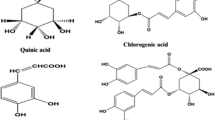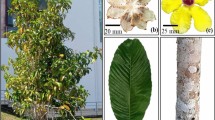Abstract
The present study was designed to investigate the antidiarrhoeal potential of 50% ethanolic extract of Cinnamomum tamala on experimentally induced castor oil diarrhoea, gastric emptying of phenol red meal, gastrointestinal transit of charcoal meal and in vitro mast cell degranulation activity. C. tamala extract (25, 50 and 100 mg/kg, orally) produced a dose-dependent reduction in the total amount of faecal matter in castor oil-induced diarrhoea. The mean distance travelled by charcoal meal at 50 and 100 mg/kg of extract showed a significant reduction in the secretion of gastrointestinal fluid accumulation by 32.5–65.0%. The Na+ and K+ concentrations on castor oil-induced fluid accumulation showed a greater inhibitory effect on Na+ levels than on K+ concentrations. C. tamala significantly reduced the lipid peroxidation (P < 0.001) and increased the catalase (P < 0.01) activity in comparison to the castor oil-induced groups. C. tamala leaf extract did not show any significant effect at a higher dose (15 mg/ml) on mast cell degranulation. However, the extract in the dose of 5 and 10 mg/ml conferred significant mast cell protective action (P < 0.001). The percentage of eugenol in extract is 3.8% w/w, and total tannin is 247.5 mg/g. The result indicates the Indian spice C. tamala is useful for diarrhoea.



Similar content being viewed by others
References
Showkat RM, Ali M, Kapoor R (2004) Chemical composition of essential oil of Cinnamomum tamala Nees et Eberm. Leaves. Flavour Fragr J 19:112–114
Sharma SR, Dwivedi SK, Swarup D (1996) Hypoglycaemic and hypolipidemic effects of Cinnamomum tamala Nees leaves. Indian J Exp Biol 34:372–374
Kujala TS, Loponen JM, Klika KD, Pihlaja K (2000) Phenolics and betacyanins in red beetroot (Beta vulgaris) root: distribution and effect of cold storage on the content of total phenolics and three individual compounds. J Agric Food Chem 48:5338–5342
Melo L, Thomas G, Mukherjee R (1988) Antidiarrhoeal activity of bisnordihydrotoxiferine isolated from root bark of Strychonus trinervis (Vell.) Mart. J Pharm Pharmacol 40:79–82
Scarpignato C, Capovilla T, Bertaccini G (1980) Action of caerulein on gastric emptying of the conscious rat. Arch Int Pharmacodyn 246:286–294
Norton S (1954) Quantitative determination of mast cell fragmentation of compound 48/80. Br J Pharmacol 9:494–497
Awouters F, Niemegeers CJE, Lenaerts FM, Janssen PAJ (1978) Delay of castor oil-induced diarrhoea in rats; a new way to evaluate the prostaglandin synthesis. J Pharm Pharmacol 30:41–45
Nwodo OFC, Alumanah EO (1991) Studies on Abrus precatorious seed II: antidiarrhoeal activity. J Ethnopharmacol 31:395–398
Lutterodt GD (1989) Inhibition of gastrointestinal release of acetylocholine by quercetine as a possible mode of action of Psidium guajava leaf extracts in the treatment of acute diarrhoeal disease. J Ethnopharmacol 25:235–247
Robert A, Nezamis JE, Lancaster C, Hanchar AI, Klepper MS (1976) Enteropooling assay: a test for diarrhoea produced by prostaglandins. Prostaglandins 11:809–814
Di Carlo G, Mascolo N, Izzo A, Capasso F, Autore G (1994) Effect of quercetin on gastrointestinal tract in rats and mice. Phytother Res 8:42–45
Jamall IS, Smith JC (1985) Effects of cadmium on glutathione peroxidase, superoxidase dismutase and lipid peroxidation in the rat heart: a possible mechanism of cadmium cardiotoxicity. Toxicol Appl Pharmacol 80:33–42
Claiborne A (1985) Catalase activity. In: Greenwald RA (ed) CRS handbook of methods for oxygen radical research. CRC Press, Boca Raton, pp 283–284
Nishikimi M, Rao NA, Yagi K (1972) The occurrence of superoxide anion in the reaction of reduced PMS and molecular oxygen. Biochem Biophys Res Commun 46:849–854
Kakkar P, Das B, Viswanathan PN (1984) Modified spectrophotometric assay of SOD. Ind J Biochem Biophys 2:130–132
Brandt EB, Strait RT, Hershko D, Wang Q (2003) Mast cells are required for experimental oral allergen-induced diarrhea. J Clin Invest 112:1666–1677
Pulimood MD, Anna B, Minnie M, Mathan MD (1998) Quantitative and ultrastructural analysis of rectal mucosal mast cells in acute infectious diarrhea. Dig Dis Sci 43:2111–2116
Smits GJM, Romain A (1996) Influence of aging on gastric emptying of liquids, small intestine transit, and fecal output in rats. Exp Gerontol 31:589–596
Sanders KM (1984) Evidence that prostaglandins are local regulatory agents in canine ileal circular muscles. Am J Physiol 246:G361–G366
Bruton LL (1985) Agent affecting gastrointestinal water flux and motility, digestants and bile acids. In: Gillman AG, Rall TW, Nies AS, Tayloy P (eds) The pharmacological basis of therapeutics. McGraw-Hill, New York, p 914
Rao Ch V, Amresh Kartik R, Irfan A, Rawat AKS, Pushpangadan P (2003) Protective effect of Aegle marmelos Correa fruit in gastrointestinal dysfunction in rats. Pharm Biol 41:558–563
Shoba FG, Thomas M (2001) Study of antidiarrhoeal activity of four medicinal plants in castor oil induced diarrhoea. J Ethnopharmacol 76:73–76
Manonmani S, William S, Subramanian S, Govindaswamy S (1991) Biochemical studies on the antidiarrhoeal effect of Cauvery-100, an ayurvedic formulation in rats. Biochem Int 24:701–708
Halliwell B, Gutteridge JMC, Cross CE (1992) Free radicals, antioxidants and human diseases: where are we now. J Lab Clin Med 119:598–620
Fridovich I (1986) Biological effects of superoxide radical. Arch Biochem Biophys 247:1–11
Acknowledgments
This study was supported by grants from the Department of Science and Technology, Ministry of Science and Technology, New Delhi. Authors are highly thankful to Dr. M. P. Dubey, Retired Scientist and Head, Department of Pharmacology, Central Drug Research Institute, Lucknow, India, for his critical advice during the course of study. Authors are also thankful to the Director of NBRI for providing necessary facilities.
Author information
Authors and Affiliations
Corresponding author
Rights and permissions
About this article
Cite this article
Rao, C.V., Vijayakumar, M., Sairam, K. et al. Antidiarrhoeal activity of the standardised extract of Cinnamomum tamala in experimental rats. J Nat Med 62, 396–402 (2008). https://doi.org/10.1007/s11418-008-0258-8
Received:
Accepted:
Published:
Issue Date:
DOI: https://doi.org/10.1007/s11418-008-0258-8




